[English] 日本語
 Yorodumi
Yorodumi- PDB-8i0q: Structure of beta-arrestin1 in complex with a phosphopeptide corr... -
+ Open data
Open data
- Basic information
Basic information
| Entry | Database: PDB / ID: 8i0q | ||||||
|---|---|---|---|---|---|---|---|
| Title | Structure of beta-arrestin1 in complex with a phosphopeptide corresponding to the human C-X-C chemokine receptor type 4, CXCR4 (Local refine) | ||||||
 Components Components |
| ||||||
 Keywords Keywords |  SIGNALING PROTEIN/IMMUNE SYSTEM / SIGNALING PROTEIN/IMMUNE SYSTEM /  GPCR / GPCR /  Arrestin / Arrestin /  SIGNALING PROTEIN / SIGNALING PROTEIN /  SIGNALING PROTEIN-IMMUNE SYSTEM complex SIGNALING PROTEIN-IMMUNE SYSTEM complex | ||||||
| Function / homology |  Function and homology information Function and homology information V2 vasopressin receptor binding / V2 vasopressin receptor binding /  alpha-1A adrenergic receptor binding / alpha-1A adrenergic receptor binding /  follicle-stimulating hormone receptor binding / Activation of SMO / sensory perception of touch / C-X-C motif chemokine 12 receptor activity / regulation of viral process / G alpha (s) signalling events / follicle-stimulating hormone receptor binding / Activation of SMO / sensory perception of touch / C-X-C motif chemokine 12 receptor activity / regulation of viral process / G alpha (s) signalling events /  alpha-1B adrenergic receptor binding / positive regulation of vascular wound healing ... alpha-1B adrenergic receptor binding / positive regulation of vascular wound healing ... V2 vasopressin receptor binding / V2 vasopressin receptor binding /  alpha-1A adrenergic receptor binding / alpha-1A adrenergic receptor binding /  follicle-stimulating hormone receptor binding / Activation of SMO / sensory perception of touch / C-X-C motif chemokine 12 receptor activity / regulation of viral process / G alpha (s) signalling events / follicle-stimulating hormone receptor binding / Activation of SMO / sensory perception of touch / C-X-C motif chemokine 12 receptor activity / regulation of viral process / G alpha (s) signalling events /  alpha-1B adrenergic receptor binding / positive regulation of vascular wound healing / positive regulation of macrophage migration inhibitory factor signaling pathway / follicle-stimulating hormone signaling pathway / protein phosphorylated amino acid binding / positive regulation of mesenchymal stem cell migration / alpha-1B adrenergic receptor binding / positive regulation of vascular wound healing / positive regulation of macrophage migration inhibitory factor signaling pathway / follicle-stimulating hormone signaling pathway / protein phosphorylated amino acid binding / positive regulation of mesenchymal stem cell migration /  angiotensin receptor binding / neuron recognition / response to ultrasound / response to tacrolimus / telencephalon cell migration / C-X-C chemokine receptor activity / Specification of primordial germ cells / CXCL12-activated CXCR4 signaling pathway / Lysosome Vesicle Biogenesis / AP-2 adaptor complex binding / angiotensin receptor binding / neuron recognition / response to ultrasound / response to tacrolimus / telencephalon cell migration / C-X-C chemokine receptor activity / Specification of primordial germ cells / CXCL12-activated CXCR4 signaling pathway / Lysosome Vesicle Biogenesis / AP-2 adaptor complex binding /  myosin light chain binding / Golgi Associated Vesicle Biogenesis / MAP2K and MAPK activation / Ub-specific processing proteases / myosin light chain binding / Golgi Associated Vesicle Biogenesis / MAP2K and MAPK activation / Ub-specific processing proteases /  myelin maintenance / positive regulation of vasculature development / myelin maintenance / positive regulation of vasculature development /  regulation of programmed cell death / positive regulation of smooth muscle cell apoptotic process / C-C chemokine receptor activity / endothelial tube morphogenesis / endothelial cell differentiation / negative regulation of interleukin-8 production / Cargo recognition for clathrin-mediated endocytosis / C-C chemokine binding / Signaling by ROBO receptors / regulation of programmed cell death / positive regulation of smooth muscle cell apoptotic process / C-C chemokine receptor activity / endothelial tube morphogenesis / endothelial cell differentiation / negative regulation of interleukin-8 production / Cargo recognition for clathrin-mediated endocytosis / C-C chemokine binding / Signaling by ROBO receptors /  Clathrin-mediated endocytosis / clathrin adaptor activity / Clathrin-mediated endocytosis / clathrin adaptor activity /  regulation of chemotaxis / positive regulation of chemotaxis / cellular response to organonitrogen compound / Formation of definitive endoderm / positive regulation of dendrite extension / regulation of G protein-coupled receptor signaling pathway / arrestin family protein binding / G protein-coupled receptor internalization / anchoring junction / Thrombin signalling through proteinase activated receptors (PARs) / Chemokine receptors bind chemokines / dendritic cell chemotaxis / mitogen-activated protein kinase kinase binding / positive regulation of Rho protein signal transduction / regulation of chemotaxis / positive regulation of chemotaxis / cellular response to organonitrogen compound / Formation of definitive endoderm / positive regulation of dendrite extension / regulation of G protein-coupled receptor signaling pathway / arrestin family protein binding / G protein-coupled receptor internalization / anchoring junction / Thrombin signalling through proteinase activated receptors (PARs) / Chemokine receptors bind chemokines / dendritic cell chemotaxis / mitogen-activated protein kinase kinase binding / positive regulation of Rho protein signal transduction /  clathrin binding / positive regulation of oligodendrocyte differentiation / clathrin binding / positive regulation of oligodendrocyte differentiation /  stress fiber assembly / negative regulation of Notch signaling pathway / epithelial cell development / cell leading edge / stress fiber assembly / negative regulation of Notch signaling pathway / epithelial cell development / cell leading edge /  pseudopodium / cellular response to cytokine stimulus / positive regulation of insulin secretion involved in cellular response to glucose stimulus / cysteine-type endopeptidase inhibitor activity involved in apoptotic process / detection of temperature stimulus involved in sensory perception of pain / pseudopodium / cellular response to cytokine stimulus / positive regulation of insulin secretion involved in cellular response to glucose stimulus / cysteine-type endopeptidase inhibitor activity involved in apoptotic process / detection of temperature stimulus involved in sensory perception of pain /  small molecule binding / negative regulation of interleukin-6 production / regulation of calcium ion transport / positive regulation of receptor internalization / small molecule binding / negative regulation of interleukin-6 production / regulation of calcium ion transport / positive regulation of receptor internalization /  phototransduction / Binding and entry of HIV virion / phototransduction / Binding and entry of HIV virion /  coreceptor activity / detection of mechanical stimulus involved in sensory perception of pain / coreceptor activity / detection of mechanical stimulus involved in sensory perception of pain /  regulation of cell adhesion / regulation of cell adhesion /  clathrin-coated pit / negative regulation of protein ubiquitination / cardiac muscle contraction / clathrin-coated pit / negative regulation of protein ubiquitination / cardiac muscle contraction /  insulin-like growth factor receptor binding / insulin-like growth factor receptor binding /  visual perception / visual perception /  neurogenesis / neurogenesis /  GTPase activator activity / cell chemotaxis / negative regulation of protein phosphorylation / response to activity / GTPase activator activity / cell chemotaxis / negative regulation of protein phosphorylation / response to activity /  ubiquitin binding / positive regulation of protein ubiquitination / G protein-coupled receptor binding / G protein-coupled receptor activity / nuclear estrogen receptor binding / calcium-mediated signaling / ubiquitin binding / positive regulation of protein ubiquitination / G protein-coupled receptor binding / G protein-coupled receptor activity / nuclear estrogen receptor binding / calcium-mediated signaling /  phosphoprotein binding / phosphoprotein binding /  brain development / brain development /  neuron migration / response to virus / adenylate cyclase-modulating G protein-coupled receptor signaling pathway / negative regulation of ERK1 and ERK2 cascade / neuron migration / response to virus / adenylate cyclase-modulating G protein-coupled receptor signaling pathway / negative regulation of ERK1 and ERK2 cascade /  endocytosis / cellular response to xenobiotic stimulus / late endosome endocytosis / cellular response to xenobiotic stimulus / late endosomeSimilarity search - Function | ||||||
| Biological species |   Rattus norvegicus (Norway rat) Rattus norvegicus (Norway rat)  Mus musculus (house mouse) Mus musculus (house mouse)  Homo sapiens (human) Homo sapiens (human) | ||||||
| Method |  ELECTRON MICROSCOPY / ELECTRON MICROSCOPY /  single particle reconstruction / single particle reconstruction /  cryo EM / Resolution: 4.45 Å cryo EM / Resolution: 4.45 Å | ||||||
 Authors Authors | Maharana, J. / Sarma, P. / Yadav, M.K. / Banerjee, R. / Shukla, A.K. | ||||||
| Funding support |  India, 1items India, 1items
| ||||||
 Citation Citation |  Journal: Mol.Cell / Year: 2023 Journal: Mol.Cell / Year: 2023Title: Structure of beta-arrestin in complex with a phosphopeptide Authors: Maharana, J. / Sarma, P. / Yadav, M.K. / Banerjee, R. / Shukla, A.K. | ||||||
| History |
|
- Structure visualization
Structure visualization
| Structure viewer | Molecule:  Molmil Molmil Jmol/JSmol Jmol/JSmol |
|---|
- Downloads & links
Downloads & links
- Download
Download
| PDBx/mmCIF format |  8i0q.cif.gz 8i0q.cif.gz | 212.6 KB | Display |  PDBx/mmCIF format PDBx/mmCIF format |
|---|---|---|---|---|
| PDB format |  pdb8i0q.ent.gz pdb8i0q.ent.gz | 167.6 KB | Display |  PDB format PDB format |
| PDBx/mmJSON format |  8i0q.json.gz 8i0q.json.gz | Tree view |  PDBx/mmJSON format PDBx/mmJSON format | |
| Others |  Other downloads Other downloads |
-Validation report
| Arichive directory |  https://data.pdbj.org/pub/pdb/validation_reports/i0/8i0q https://data.pdbj.org/pub/pdb/validation_reports/i0/8i0q ftp://data.pdbj.org/pub/pdb/validation_reports/i0/8i0q ftp://data.pdbj.org/pub/pdb/validation_reports/i0/8i0q | HTTPS FTP |
|---|
-Related structure data
| Related structure data |  35106MC  8go8C  8gocC 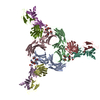 8gooC 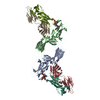 8gp3C  8i0nC 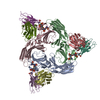 8i0zC 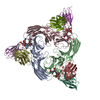 8i10C M: map data used to model this data C: citing same article ( |
|---|---|
| Similar structure data | Similarity search - Function & homology  F&H Search F&H Search |
- Links
Links
- Assembly
Assembly
| Deposited unit | 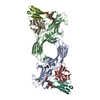
|
|---|---|
| 1 |
|
- Components
Components
| #1: Protein |  Arrestin / Arrestin beta-1 Arrestin / Arrestin beta-1Mass: 47088.508 Da / Num. of mol.: 2 Source method: isolated from a genetically manipulated source Source: (gene. exp.)   Rattus norvegicus (Norway rat) / Gene: Arrb1 / Production host: Rattus norvegicus (Norway rat) / Gene: Arrb1 / Production host:   Escherichia coli (E. coli) / References: UniProt: P29066 Escherichia coli (E. coli) / References: UniProt: P29066#2: Antibody | Mass: 25512.354 Da / Num. of mol.: 2 Source method: isolated from a genetically manipulated source Source: (gene. exp.)   Mus musculus (house mouse) / Production host: Mus musculus (house mouse) / Production host:   Escherichia coli (E. coli) Escherichia coli (E. coli)#3: Antibody | Mass: 23435.064 Da / Num. of mol.: 2 Source method: isolated from a genetically manipulated source Source: (gene. exp.)   Mus musculus (house mouse) / Production host: Mus musculus (house mouse) / Production host:   Escherichia coli (E. coli) Escherichia coli (E. coli)#4: Protein/peptide | Mass: 2380.530 Da / Num. of mol.: 2 / Source method: obtained synthetically / Source: (synth.)   Homo sapiens (human) / References: UniProt: P61073 Homo sapiens (human) / References: UniProt: P61073Has ligand of interest | Y | |
|---|
-Experimental details
-Experiment
| Experiment | Method:  ELECTRON MICROSCOPY ELECTRON MICROSCOPY |
|---|---|
| EM experiment | Aggregation state: PARTICLE / 3D reconstruction method:  single particle reconstruction single particle reconstruction |
- Sample preparation
Sample preparation
| Component |
| |||||||||||||||||||||||||||||||||||
|---|---|---|---|---|---|---|---|---|---|---|---|---|---|---|---|---|---|---|---|---|---|---|---|---|---|---|---|---|---|---|---|---|---|---|---|---|
| Molecular weight | Value: 0.19 MDa / Experimental value: YES | |||||||||||||||||||||||||||||||||||
| Source (natural) |
| |||||||||||||||||||||||||||||||||||
| Source (recombinant) |
| |||||||||||||||||||||||||||||||||||
| Buffer solution | pH: 7.4 | |||||||||||||||||||||||||||||||||||
| Buffer component |
| |||||||||||||||||||||||||||||||||||
| Specimen | Embedding applied: NO / Shadowing applied: NO / Staining applied : NO / Vitrification applied : NO / Vitrification applied : YES : YES | |||||||||||||||||||||||||||||||||||
Vitrification | Instrument: LEICA EM GP / Cryogen name: ETHANE / Humidity: 90 % / Chamber temperature: 283.15 K / Details: Blotted for 3 seconds before plunging. |
- Electron microscopy imaging
Electron microscopy imaging
| Microscopy | Model: TFS GLACIOS |
|---|---|
| Electron gun | Electron source : :  FIELD EMISSION GUN / Accelerating voltage: 200 kV / Illumination mode: FLOOD BEAM FIELD EMISSION GUN / Accelerating voltage: 200 kV / Illumination mode: FLOOD BEAM |
| Electron lens | Mode: BRIGHT FIELD Bright-field microscopy / Nominal magnification: 46000 X / Nominal defocus max: 2500 nm / Nominal defocus min: 500 nm / Cs Bright-field microscopy / Nominal magnification: 46000 X / Nominal defocus max: 2500 nm / Nominal defocus min: 500 nm / Cs : 2.7 mm / Alignment procedure: COMA FREE : 2.7 mm / Alignment procedure: COMA FREE |
| Specimen holder | Cryogen: NITROGEN |
| Image recording | Electron dose: 49.3 e/Å2 / Detector mode: COUNTING / Film or detector model: GATAN K3 (6k x 4k) / Num. of real images: 5637 |
| Image scans | Movie frames/image: 40 |
- Processing
Processing
| EM software |
| ||||||||||||||||||||||||||||
|---|---|---|---|---|---|---|---|---|---|---|---|---|---|---|---|---|---|---|---|---|---|---|---|---|---|---|---|---|---|
CTF correction | Type: NONE | ||||||||||||||||||||||||||||
| Particle selection | Num. of particles selected: 3236193 | ||||||||||||||||||||||||||||
| Symmetry | Point symmetry : C2 (2 fold cyclic : C2 (2 fold cyclic ) ) | ||||||||||||||||||||||||||||
3D reconstruction | Resolution: 4.45 Å / Resolution method: FSC 0.143 CUT-OFF / Num. of particles: 86525 / Symmetry type: POINT | ||||||||||||||||||||||||||||
| Atomic model building | Protocol: FLEXIBLE FIT / Space: REAL | ||||||||||||||||||||||||||||
| Atomic model building | PDB-ID: 8GP3 |
 Movie
Movie Controller
Controller









 PDBj
PDBj


















